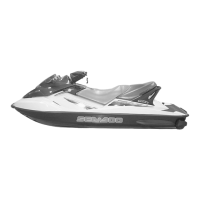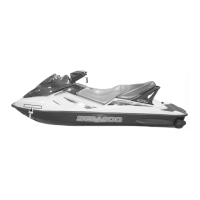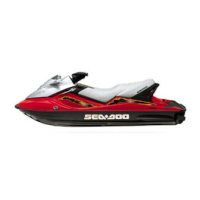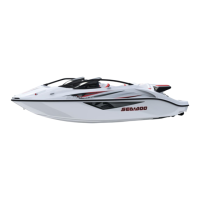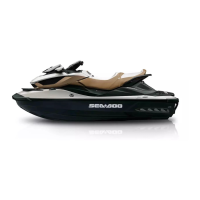Section06ELECTRICALSYSTEM
Subsection 02 (CHARGING SYSTEM)
Cleaning
Clean the battery casing, caps, cables and battery
posts using a solution of baking soda and water.
CAUTION: Do not allow cleaning solution to en-
ter battery.
Remove corrosion from battery cable terminals
and battery posts using a firm wire brush. Rinse
with clear water and dry well.
Inspection
Visually inspect battery casing for cracks or other
possible damage. If casing is damaged, replace
battery and thoroughly clean battery tray and close
area with water and baking soda.
Inspect battery posts for security of mounting.
Inspect for cracked or damaged battery caps, re-
place defective caps.
NOTE: Hand tighten caps then tighten an addition-
al 1/4 turn using a 20 mm (3/4 in) socket. Using
other tool could damage the plastic battery caps.
WARNING
Battery electrolyte is caustic. To prevent
spillage, battery cell cap should be sufficient-
ly tight to properly seal.
WARNING
Battery caps do not have vent holes. Make
sure that vent line is not obstructed.
Electrolyte Level
Check electrolyte level in each cell, add distilled
water up to upper level line.
CAUTION: Add only distilled water in an acti-
vated battery.
Battery Testing
There are 2 types of battery tests: electrolyte
reading and load test. An electrolyte reading is
made on a battery without discharging current. It
is the simplest and commonly used. A load test
gives more accuracy of the battery condition.
Electrolyte Reading
Check charge condition using either a hydrometer
or multimeter.
With a multimeter, voltage readings appear in-
stantly to show the state of charge. Always
respect polarity. A fully charge battery will have a
reading of 12.6 Vdc.
A hydrometer measures the charge of a battery in
terms of specific gravity of the electrolyte. A fully
charge battery will have a specific gravity between
1.265 to 1.280.
Most hydrometers give a true reading at 21°C
(70°F).
A17E0JA
1
1. Specific gravity 1.265
In order to obtain correct readings, adjust the
initial reading by adding .004 points to the hy-
drometer readings for each 5.5°C(10°F) above
21°C(70°F) and by subtracting .004 point for
every 5.5°C(10°F) below 21°C(70°F).
This chart will be useful to find the correct reading.
ELECTROLYTE
TEMPERATURE
°C °F
OPERATION TO
PERFORM
38 100 .012
32 90 .008
27 80 .004
Add to the
reading
21 70
CORRECT READING
16 60 .004
10 50 .008
4
40 .012
-1
30 .016
Subtract
from the
reading
158 smr2005-016
